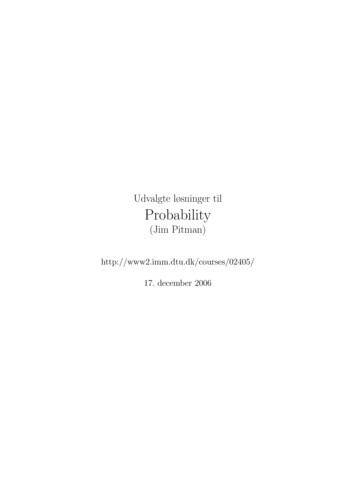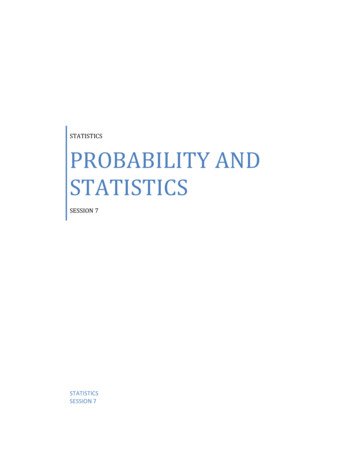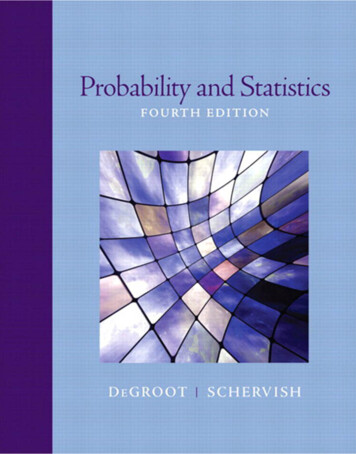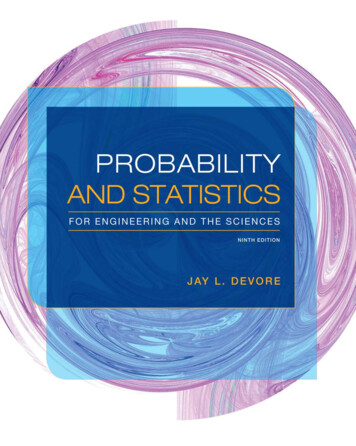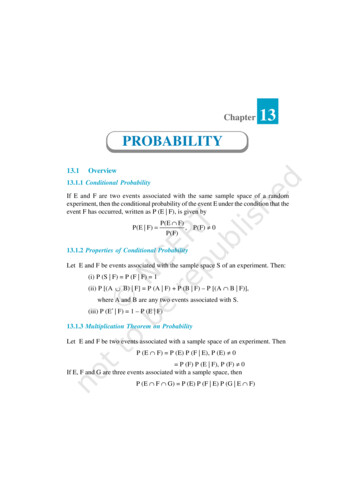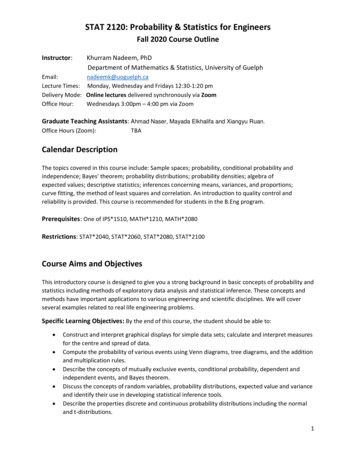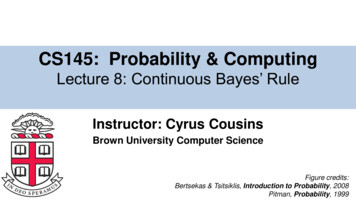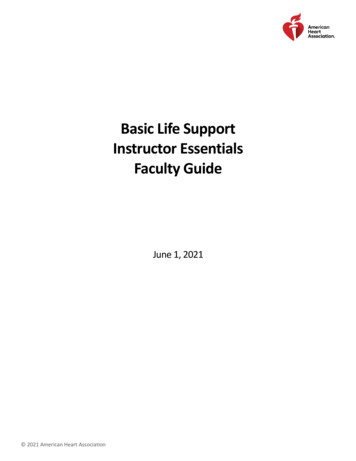
Transcription
Instructor Solution ManualProbability and Statistics for Engineers and Scientists(3rd Edition)Anthony Hayter
1Instructor Solution ManualThis instructor solution manual to accompany the third edition of“Probability and Statistics for Engineers and Scientists” by Anthony Hayterprovides worked solutions and answers to all of the problems given in the textbook. The studentsolution manual provides worked solutions and answers to only the odd-numbered problemsgiven at the end of the chapter sections. In addition to the material contained in the studentsolution manual, this instructor manual therefore provides worked solutions and answers tothe even-numbered problems given at the end of the chapter sections together with all of thesupplementary problems at the end of each chapter.
2
Contents1 Probability Theory1.1 Probabilities . . . . . . . . . . . . .1.2 Events . . . . . . . . . . . . . . . .1.3 Combinations of Events . . . . . .1.4 Conditional Probability . . . . . .1.5 Probabilities of Event Intersections1.6 Posterior Probabilities . . . . . . .1.7 Counting Techniques . . . . . . . .1.9 Supplementary Problems . . . . . .2 Random Variables2.1 Discrete Random Variables . . . . . . .2.2 Continuous Random Variables . . . . . .2.3 The Expectation of a Random Variable2.4 The Variance of a Random Variable . .2.5 Jointly Distributed Random Variables .2.6 Combinations and Functions of Random2.8 Supplementary Problems . . . . . . . . . . . . . . . . . . . . . . . . . . . . . . . . . .variables . . . . . .3 Discrete Probability Distributions3.1 The Binomial Distribution . . . . . . . . . . . . . . .3.2 The Geometric and Negative Binomial Distributions3.3 The Hypergeometric Distribution . . . . . . . . . . .3.4 The Poisson Distribution . . . . . . . . . . . . . . .3.5 The Multinomial Distribution . . . . . . . . . . . . .3.7 Supplementary Problems . . . . . . . . . . . . . . . .4 Continuous Probability Distributions4.1 The Uniform Distribution . . . . . . .4.2 The Exponential Distribution . . . . .4.3 The Gamma Distribution . . . . . . .4.4 The Weibull Distribution . . . . . . .4.5 The Beta Distribution . . . . . . . . .4.7 Supplementary Problems . . . . . . . 7109.113. 113. 116. 119. 121. 123. 125.
45 The5.15.25.35.45.6CONTENTSNormal DistributionProbability Calculations using the Normal Distribution . .Linear Combinations of Normal Random Variables . . . . .Approximating Distributions with the Normal DistributionDistributions Related to the Normal Distribution . . . . . .Supplementary Problems . . . . . . . . . . . . . . . . . . . .6 Descriptive Statistics6.1 Experimentation . . . . .6.2 Data Presentation . . . .6.3 Sample Statistics . . . . .6.6 Supplementary Problems .7 Statistical Estimation and Sampling Distributions7.2 Properties of Point Estimates . . . . . . . . . . . . .7.3 Sampling Distributions . . . . . . . . . . . . . . . . .7.4 Constructing Parameter Estimates . . . . . . . . . .7.6 Supplementary Problems . . . . . . . . . . . . . . . .129. 129. 135. 140. 144. 148.157. 157. 159. 161. 164.167. 167. 170. 176. 1778 Inferences on a Population Mean1838.1 Confidence Intervals . . . . . . . . . . . . . . . . . . . . . . . . . . . . . . . . . . 1838.2 Hypothesis Testing . . . . . . . . . . . . . . . . . . . . . . . . . . . . . . . . . . . 1898.5 Supplementary Problems . . . . . . . . . . . . . . . . . . . . . . . . . . . . . . . . 1969 Comparing Two Population Means2059.2 Analysis of Paired Samples . . . . . . . . . . . . . . . . . . . . . . . . . . . . . . 2059.3 Analysis of Independent Samples . . . . . . . . . . . . . . . . . . . . . . . . . . . 2099.6 Supplementary Problems . . . . . . . . . . . . . . . . . . . . . . . . . . . . . . . . 21810 Discrete Data Analysis10.1 Inferences on a Population Proportion . . . . . . . . . . .10.2 Comparing Two Population Proportions . . . . . . . . . .10.3 Goodness of Fit Tests for One-way Contingency Tables . .10.4 Testing for Independence in Two-way Contingency Tables10.6 Supplementary Problems . . . . . . . . . . . . . . . . . . .11 The11.111.211.4.225225232240246251Analysis of Variance263One Factor Analysis of Variance . . . . . . . . . . . . . . . . . . . . . . . . . . . 263Randomized Block Designs . . . . . . . . . . . . . . . . . . . . . . . . . . . . . . 273Supplementary Problems . . . . . . . . . . . . . . . . . . . . . . . . . . . . . . . . 28112 Simple Linear Regression and Correlation12.1 The Simple Linear Regression Model . . . . . .12.2 Fitting the Regression Line . . . . . . . . . . .12.3 Inferences on the Slope Parameter β̂1 . . . . . .12.4 Inferences on the Regression Line . . . . . . . .12.5 Prediction Intervals for Future Response Values12.6 The Analysis of Variance Table . . . . . . . . .12.7 Residual Analysis . . . . . . . . . . . . . . . . .287287289292296298300302
CONTENTS512.8 Variable Transformations . . . . . . . . . . . . . . . . . . . . . . . . . . . . . . . 30312.9 Correlation Analysis . . . . . . . . . . . . . . . . . . . . . . . . . . . . . . . . . . 30512.11Supplementary Problems . . . . . . . . . . . . . . . . . . . . . . . . . . . . . . . . 30613 Multiple Linear Regression and Nonlinear Regression13.1 Introduction to Multiple Linear Regression . . . . . . . .13.2 Examples of Multiple Linear Regression . . . . . . . . . .13.3 Matrix Algebra Formulation of Multiple Linear Regression13.4 Evaluating Model Accuracy . . . . . . . . . . . . . . . . .13.6 Supplementary Problems . . . . . . . . . . . . . . . . . . .317. 317. 320. 322. 327. 32814 Multifactor Experimental Design and Analysis33314.1 Experiments with Two Factors . . . . . . . . . . . . . . . . . . . . . . . . . . . . 33314.2 Experiments with Three or More Factors . . . . . . . . . . . . . . . . . . . . . . 33614.3 Supplementary Problems . . . . . . . . . . . . . . . . . . . . . . . . . . . . . . . . 34015 Nonparametric Statistical Analysis15.1 The Analysis of a Single Population .15.2 Comparing Two Populations . . . . .15.3 Comparing Three or More Populations15.4 Supplementary Problems . . . . . . . .16 Quality Control Methods16.2 Statistical Process Control16.3 Variable Control Charts .16.4 Attribute Control Charts16.5 Acceptance Sampling . . .16.6 Supplementary Problems .17 Reliability Analysis and Life Testing17.1 System Reliability . . . . . . . . . .17.2 Modeling Failure Rates . . . . . . .17.3 Life Testing . . . . . . . . . . . . . .17.4 Supplementary Problems . . . . . . .343. 343. 347. 350. 354.359. 359. 361. 363. 364. 365.367. 367. 369. 372. 374
6CONTENTS
Chapter 1Probability Theory1.11.1.1ProbabilitiesS {(head, head, head), (head, head, tail), (head, tail, head), (head, tail, tail),(tail, head, head), (tail, head, tail), (tail, tail, head), (tail, tail, tail)}1.1.2S {0 females, 1 female, 2 females, 3 females, . . . , n females}1.1.3S {0,1,2,3,4}1.1.4S {January 1, January 2, . , February 29, . , December 31}1.1.5S {(on time, satisfactory), (on time, unsatisfactory),(late, satisfactory), (late, unsatisfactory)}1.1.6S {(red, shiny), (red, dull), (blue, shiny), (blue, dull)}1.1.7(a)p1 p 1 p 0.5(b)p1 p 2 p (c) p 0.25 1.1.8p1 p23 130.13 0.24 0.07 0.38 P (V ) 1 P (V ) 0.187
8CHAPTER 1. PROBABILITY THEORY1.1.90.08 0.20 0.33 P (IV ) P (V ) 1 P (IV ) P (V ) 1 0.61 0.39Therefore, 0 P (V ) 0.39.If P (IV ) P (V ) then P (V ) 0.195.1.1.10P (I) 2 P (II) and P (II) 3 P (III) P (I) 6 P (III)Therefore,P (I) P (II) P (III) 1so that(6 P (III)) (3 P (III)) P (III) 1.Consequently,P (III) 110 ,P (II) 3 P (III) andP (I) 6 P (III) 610 .310
1.2. EVENTS1.21.2.19Events(a) 0.13 P (b) 0.48 0.02 0.22 1 P (b) 0.15(b) A {c, d} so that P (A) P (c) P (d) 0.48 0.02 0.50(c) P (A0 ) 1 P (A) 1 0.5 0.501.2.2(a) P (A) P (b) P (c) P (e) 0.27 so P (b) 0.11 0.06 0.27and hence P (b) 0.10(b) P (A0 ) 1 P (A) 1 0.27 0.73(c) P (A0 ) P (a) P (d) P (f ) 0.73 so 0.09 P (d) 0.29 0.73and hence P (d) 0.351.2.3Over a four year period including one leap year, the number of days is(3 365) 366 1461.The number of January days is 4 31 124and the number of February days is (3 28) 29 113.The answers are therefore1.2.41241461and1131461 .S {1, 2, 3, 4, 5, 6}Prime {1, 2, 3, 5}All the events in S are equally likely to occur and each has a probability of16so thatP (Prime) P (1) P (2) P (3) P (5) 1.2.546 32 .See Figure 1.10.The event that the score on at least one of the two dice is a prime number consistsof the following 32 outcomes:{(1,1), (1,2), (1,3), (1,4), (1,5), (1,6), (2,1), (2,2), (2,3), (2,4) (2,5), (2,6), (3,1), (3,2),(3,3), (3,4), (3,5), (3,6), (4,1), (4,2), (4,3), (4,5), (5,1), (5,2), (5,3), (5,4), (5,5), (5,6),(6,1), (6,2), (6,3), (6,5)}Each outcome in S is equally likely to occur with a probability ofP (at least one score is a prime number) 32 136 3236 136so that89.The complement of this event is the event that neither score is a prime number whichincludes the following four outcomes:
10CHAPTER 1. PROBABILITY THEORY{(4,4), (4,6), (6,4), (6,6)}Therefore, P (neither score prime) 1.2.6136 136 136 136 91 .In Figure 1.10 let (x, y) represent the outcome that the score on the red die is x andthe score on the blue die is y. The event that the score on the red die is strictlygreater than the score on the blue die consists of the following 15 outcomes:{(2,1), (3,1), (3,2), (4,1), (4,2), (4,3), (5,1), (5,2), (5,3), (5,4), (6,1), (6,2), (6,3),(6,4), (6,5)}The probability of each outcome is136so the required probability is 15 136 512 .This probability is less than 0.5 because of the possibility that both scores are equal.The complement of this event is the event that the red die has a score less than or75 12.equal to the score on the blue die which has a probability of 1 121.2.7P ( or ) P (A ) P (K ) . . . P (2 ) P (A ) P (K ) . . . P (2 )111 52 . . . 52 2652 21.2.8P (draw an ace) P (A ) P (A ) P (A ) P (A ) 1.2.9152 152 152 152 452 113(a) Let the four players be named A, B, C, and T for Terica, and let the notation(X, Y ) indicate that player X is the winner and player Y is the runner up.The sample space consists of the 12 outcomes:S {(A,B), (A,C), (A,T), (B,A), (B,C), (B,T), (C,A), (C,B), (C,T), (T,A),(T,B), (T,C)}The event ‘Terica is winner’ consists of the 3 outcomes {(T,A), (T,B), (T,C)}.1Since each outcome in S is equally likely to occur with a probability of 12itfollows that3P (Terica is winner) 12 41 .(b) The event ‘Terica is winner or runner up’ consists of 6 out of the 12 outcomesso that6P (Terica is winner or runner up) 12 21 .
1.2. EVENTS1.2.1011(a) See Figure 1.24.P (Type I battery lasts longest) P ((II, III, I)) P ((III, II, I)) 0.39 0.03 0.42(b) P (Type I battery lasts shortest) P ((I, II, III)) P ((I, III, II)) 0.11 0.07 0.18(c) P (Type I battery does not last longest) 1 P (Type I battery lasts longest) 1 0.42 0.58(d) P (Type I battery last longer than Type II) P ((II, I, III)) P ((II, III, I)) P ((III, II, I)) 0.24 0.39 0.03 0.661.2.11(a) See Figure 1.25.The event ‘both assembly lines are shut down’ consists of the single outcome{(S,S)}.Therefore,P (both assembly lines are shut down) 0.02.(b) The event ‘neither assembly line is shut down’ consists of the outcomes{(P,P), (P,F), (F,P), (F,F)}.Therefore,P (neither assembly line is shut down) P ((P, P )) P ((P, F )) P ((F, P )) P ((F, F )) 0.14 0.2 0.21 0.19 0.74.(c) The event ‘at least one assembly line is at full capacity’ consists of the outcomes{(S,F), (P,F), (F,F), (F,S), (F,P)}.Therefore,P (at least one assembly line is at full capacity) P ((S, F )) P ((P, F )) P ((F, F )) P ((F, S)) P ((F, P )) 0.05 0.2 0.19 0.06 0.21 0.71.(d) The event ‘exactly one assembly line at full capacity’ consists of the outcomes{(S,F), (P,F), (F,S), (F,P)}.Therefore,P (exactly one assembly line at full capacity) P ((S, F )) P ((P, F )) P ((F, S)) P ((F, P ))
12CHAPTER 1. PROBABILITY THEORY 0.05 0.20 0.06 0.21 0.52.The complement of ‘neither assembly line is shut down’ is the event ‘at least oneassembly line is shut down’ which consists of the outcomes{(S,S), (S,P), (S,F), (P,S), (F,S)}.The complement of ‘at least one assembly line is at full capacity’ is the event ‘neitherassembly line is at full capacity’ which consists of the outcomes{(S,S), (S,P), (P,S), (P,P)}.1.2.12The sample space isS {(H,H,H), (H,T,H), (H,T,T), (H,H,T), (T,H,H), (T,H,T), (T,T,H), (T,T,T)}with each outcome being equally likely with a probability of 18 .The event ‘two heads obtained in succession’ consists of the three outcomes{(H,H,H), (H,H,T), (T,H,H)}so that P (two heads in succession) 83 .
1.3. COMBINATIONS OF EVENTS1.313Combinations of Events1.3.1The event A contains the outcome 0 while the empty set does not contain anyoutcomes.1.3.2(a) See Figure 1.55.P (B) 0.01 0.02 0.05 0.11 0.08 0.06 0.13 0.46(b) P (B C) 0.02 0.05 0.11 0.18(c) P (A C) 0.07 0.05 0.01 0.02 0.05 0.08 0.04 0.11 0.07 0.11 0.61(d) P (A B C) 0.02 0.05 0.07(e) P (A B C) 1 0.03 0.04 0.05 0.88(f) P (A0 B) 0.08 0.06 0.11 0.13 0.38(g) P (B 0 C) 0.04 0.03 0.05 0.11 0.05 0.02 0.08 0.04 0.11 0.07 0.07 0.05 0.72(h) P (A (B C)) 0.07 0.05 0.01 0.02 0.05 0.08 0.04 0.11 0.43(i) P ((A B) C) 0.11 0.05 0.02 0.08 0.04 0.30(j) P (A0 C) 0.04 0.03 0.05 0.08 0.06 0.13 0.11 0.11 0.07 0.02 0.05 0.08 0.04 0.87P (A0 C)0 1 P (A0 C) 1 0.87 0.131.3.4(a) A B {females with black hair}(b) A C 0 {all females and any man who does not have brown eyes}(c) A0 B C {males with black hair and brown eyes}(d) A (B C) {females with either black hair or brown eyes or both}1.3.5Yes, because a card must be drawn from either a red suit or a black suit but it cannotbe from both at the same time.No, because the ace of hearts could be drawn.
14CHAPTER 1. PROBABILITY THEORY1.3.6P (A B) P (A) P (B) P (A B) 1so thatP (B) 1 0.4 0.3 0.9.Also, P (B) P (A B) 0.3so that0.3 P (B) 0.9.1.3.7Since P (A B) P (A) P (B) P (A B)it follows thatP (B) P (A B) P (A) P (A B) 0.8 0.5 0.1 0.4.1.3.8S {1, 2, 3, 4, 5, 6} where each outcome is equally likely with a probability of 16 .The events A, B, and B 0 are A {2, 4, 6}, B {1, 2, 3, 5} and B 0 {4, 6}.(a) A B {2} so that P (A B) 16(b) A B {1, 2, 3, 4, 5, 6} so that P (A B) 1(c) A B 0 {4, 6} so that P (A B 0 ) 1.3.926 13Yes, the three events are mutually exclusive because the selected card can only befrom one suit.Therefore,P (A B C) P (A) P (B) P (C) 14 14 14 34 .A0 is the event ‘a heart is not obtained’ (or similarly the event ‘a club, spade, ordiamond is obtained’ ) so that B is a subset of A0 .1.3.10(a) A B {A , A }(b) A C {A , A , A , A , K , K , K , K , Q , Q , Q , Q ,J , J , J , J }(c) B C 0 {A , 2 , . . . , 10 , A , 2 , . . . , 10 }(d) B 0 C {K , K , Q , Q , J , J }A (B 0 C) {A , A , A , A , K , K , Q , Q , J , J }
1.3. COMBINATIONS OF EVENTS1.3.1115Let the event O be an on time repair and let the event S be a satisfactory repair.It is known that P (O S) 0.26, P (O) 0.74 and P (S) 0.41.We want to find P (O0 S 0 ).Since the event O0 S 0 can be written (O S)0 it follows thatP (O0 S 0 ) 1 P (O S) 1 (P (O) P (S) P (O S)) 1 (0.74 0.41 0.26) 0.11.1.3.12Let R be the event that a red ball is chosen and let S be the event that a shiny ballis chosen.It is known that P (R S) 55200 ,P (S) 91200and P (R) 79200 .Therefore, the probability that the chosen ball is either shiny or red isP (R S) P (R) P (S) P (R S) 79200115200 91200 55200 0.575.The probability of a dull blue ball isP (R0 S 0 ) 1 P (R S) 1 0.575 0.425.1.3.13Let A be the event that the patient is male, let B be the event that the patient isyounger than thirty years of age, and let C be the event that the patient is admittedto the hospital.It is given that P (A) 0.45, P (B) 0.30, P (A0 B 0 C) 0.15,and P (A0 B) 0.21.The question asks for P (A0 B 0 C 0 ).Notice thatP (A0 B 0 ) P (A0 ) P (A0 B) (1 0.45) 0.21 0.34so thatP (A0 B 0 C 0 ) P (A0 B 0 ) P (A0 B 0 C) 0.34 0.15 0.19.
16CHAPTER 1. PROBABILITY THEORY1.41.4.11.4.21.4.3Conditional ProbabilitySee Figure 1.55.(a) P (A B) P (A B)P (B) 0.02 0.05 0.010.02 0.05 0.01 0.11 0.08 0.06 0.13(b) P (C A) P (A C)P (A) 0.02 0.05 0.08 0.040.02 0.05 0.08 0.04 0.018 0.07 0.05(c) P (B A B) P (B (A B))P (A B) P (A B)P (A B) 1(d) P (B A B) P (B (A B))P (A B) P (B)P (A B) (e) P (A A B C) P (A (A B C))P (A B C)(f) P (A B A B) P ((A B) (A B))P (A B)A {1, 2, 3, 5} and P (A) 46P (5 A)P (A) P (5)P (A) P (6 A) P (6 A)P (A) P ( )P (A) 0P (A 5) P (A 5)P (5) P (5)P (5) 10.460.46 0.32 0.08P (A)P (A B C) P (A B)P (A B) 0.321 0.04 0.05 0.030.080.7 0.3636 0.11431( 52) 26P (red suit)( 52 )P (A )(b) P (heart red suit) P (heart red suit)P (red suit) P (heart)P (red suit)(c) P (red suit heart) P (red suit heart)P (heart) P (heart)P (heart)(e) P (King red suit) 0.65714P (A red suit)P (red suit)(d) P (heart black suit) 0.5937523( 16 ) ( 23 )P (5 A) (a) P (A red suit) 0.1739P (heart black suit)P (black suit)P (King red suit)P (red suit)(f) P (King red picture card) 126( 1352 ) ( 2652 )1326 12 1P ( )P (black suit)P (K , K )P (red suit) P (King red picture card)P (red picture card) 02( 52) 26( 52 )226 113
1.4. CONDITIONAL PROBABILITY 1.4.4P (K , K )P (red picture card)17 2( 52) 6( 52)26 13P (A) is smaller than P (A B).Event B is a necessary condition for event A and so conditioning on event B increasesthe probability of event A.1.4.5There are 54 blue balls and so there are 150 54 96 red balls.Also, there are 36 shiny, red balls and so there are 96 36 60 dull, red balls.P (shiny red) P (dull red) 1.4.6P (shiny red)P (red)P (dull red)P (red) 36)( 150 96( 150)60( 150) 96)( 15060963696 5838Let the event O be an on time repair and let the event S be a satisfactory repair.It is known that P (S O) 0.85 and P (O) 0.77.The question asks for P (O S) which isP (O S) P (S O) P (O) 0.85 0.77 0.6545.1.4.7(a) It depends on the weather patterns in the particular location that is beingconsidered.(b) It increases since there are proportionally more black haired people amongbrown eyed people than there are in the general population.(c) It remains unchanged.(d) It increases.1.4.8Over a four year period including one leap year the total number of days is(3 365) 366 1461.Of these, 4 12 48 days occur on the first day of a month and so the probabilitythat a birthday falls on the first day of a month is481461 0.0329.Also, 4 31 124 days occur in March of which 4 days are March 1st.Consequently, the probability that a birthday falls on March 1st. conditional that itis in March is4124 131 0.0323.
18CHAPTER 1. PROBABILITY THEORYFinally, (3 28) 29 113 days occur in February of which 4 days are February 1st.Consequently, the probability that a birthday falls on February 1st. conditional thatit is in February is41131.4.9 0.0354.(a) Let A be the event that ‘Type I battery lasts longest’ consisting of the outcomes{(III, II, I), (II, III, I)}.Let B be the event that ‘Type I battery does not fail first’ consisting of theoutcomes {(III,II,I), (II,III,I), (II,I,III), (III,I,II)}.The event A B {(III,II,I), (II,III,I)} is the same as event A.Therefore,0.39 0.03P (A B) P P(A B)(B) 0.39 0.03 0.24 0.16 0.512.(b) Let C be the event that ‘Type II battery fails first’ consisting of the outcomes{(II,I,III), (II,III,I)}.Thus, A C {(II, III, I)} and thereforeP (A C) P (A C)P (C) 0.390.39 0.24 0.619.(c) Let D be the event that ‘Type II battery lasts longest’ consisting of the outcomes{(I,III,II), (III,I,II)}.Thus, A D and thereforeP (A D) P P(A D)(D) 0.(d) Let E be the event that ‘Type II battery does not fail first’ consisting of theoutcomes {(I,III,II), (I,II,III), (III,II,I), (III,I,II)}.Thus, A E {(III, II, I)} and thereforeP (A E) 1.4.10P (A E)P (E) 0.030.07 0.11 0.03 0.16 0.081.See Figure 1.25.(a) Let A be the event ‘both lines at full capacity’ consisting of the outcome {(F,F)}.Let B be the event ‘neither line is shut down’ consisting of the outcomes{(P,P), (P,F), (F,P), (F,F)}.Thus, A B {(F, F )} and thereforeP (A B) P (A B)P (B) 0.19(0.14 0.2 0.21 0.19) 0.257.(b) Let C be the event ‘at least one line at full capacity’ consisting of the outcomes{(F,P), (F,S), (F,F), (S,F), (P,F)}.Thus, C B {(F, P ), (F, F ), (P, F )} and thereforeP (C B) P (C B)P (B) 0.21 0.19 0.20.74 0.811.
1.4. CONDITIONAL PROBABILITY19(c) Let D be the event that ‘one line is at full capacity’ consisting of the outcomes{(F,P), (F,S), (P,F), (S,F)}.Let E be the event ‘one line is shut down’ consisting of the outcomes{(S,P), (S,F), (P,S), (F,S)}.Thus, D E {(F, S), (S, F )} and thereforeP (D E)P (E)P (D E) 0.06 0.050.06 0.05 0.07 0.06 0.458.(d) Let G be the event that ‘neither line is at full capacity’ consisting of theoutcomes {(S,S), (S,P), (P,S), (P,P)}.Let H be the event that ‘at least one line is at partial capacity’ consisting ofthe outcomes {(S,P), (P,S), (P,P), (P,F), (F,P)}.Thus, F G {(S, P ), (P, S), (P, P )} and thereforeP (F G) 1.4.11P (F G)P (G) 0.06 0.07 0.140.06 0.07 0.14 0.2 0.21 0.397.Let L, W and H be the events that the length, width and height respectively arewithin the specified tolerance limits.It is given that P (W ) 0.86, P (L W H) 0.80, P (L W H 0 ) 0.02,P (L0 W H) 0.03 and P (W H) 0.92.(a) P (W H) P (L W H) P (L0 W H) 0.80 0.03 0.83P (H) P (W H) P (W ) P (W H) 0.92 0.86 0.83 0.89P (W H H) P (W H)P (H) 0.830.89 0.9326(b) P (L W ) P (L W H) P (L W H 0 ) 0.80 0.02 0.82P (L W H L W ) 1.4.12P (L W H)P (L W ) 0.800.82 0.9756Let A be the event that the gene is of ‘type A’, and let D be the event that the geneis ‘dominant’.P (D A0 ) 0.31P (A0 D) 0.22Therefore,P (A) 1 P (A0 )1.4.13 1 P (A0 D)P (D A0 ) 1 0.220.31 0.290(a) Let E be the event that the ‘component passes on performance’, let A be theevent that the ‘component passes on appearance’, and let C be the event thatthe ‘component passes on cost’.P (A C) 0.40
20CHAPTER 1. PROBABILITY THEORYP (E A C) 0.31P (E) 0.64P (E 0 A0 C 0 ) 0.19P (E 0 A C 0 ) 0.06Therefore,P (E 0 A0 C) P (E 0 A0 ) P (E 0 A0 C 0 ) P (E 0 ) P (E 0 A) 0.19 1 P (E) P (E 0 A C) P (E 0 A C 0 ) 0.19 1 0.64 P (A C) P (E A C) 0.06 0.19 1 0.64 0.40 0.31 0.06 0.19 0.02(b) P (E A C A C) 1.4.140.310.40P (E A C)P (A C) 0.775(a) Let T be the event ‘good taste’, let S be the event ‘good size’, and let A be theevent ‘good appearance’.P (T ) 0.78P (T S) 0.69P (T S 0 A) 0.05P (S A) 0.84Therefore,0.69P (S T ) PP(T(T S)) 0.78 0.885.(b) Notice thatP (S 0 A0 ) 1 P (S A) 1 0.84 0.16.Also,P (T S 0 ) P (T ) P (T S) 0.78 0.69 0.09so thatP (T S 0 A0 ) P (T S 0 ) P (T S 0 A) 0.09 0.05 0.04.Therefore,P (T S 0 A0 ) 1.4.15P (T S 0 A0 )P (S 0 A0 ) 0.040.16 0.25.P (delay) (P (delay technical problems) P (technical problems)) (P (delay no technical problems) P (no technical problems)) (1 0.04) (0.33 0.96) 0.35681.4.16Let S be the event that a chip ‘survives 500 temperature cycles’ and let A be theevent that the chip was ‘made by company A’.P (S) 0.42P (A S 0 ) 0.73
1.4. CONDITIONAL PROBABILITYTherefore,P (A0 S 0 ) P (S 0 ) P (A0 S 0 ) (1 0.42) (1 0.73) 0.1566.21
22CHAPTER 1. PROBABILITY THEORY1.51.5.1Probabilities of Event Intersections(a) P (both cards are picture cards) 1252(b) P (both cards are from red suits) 26521151 25511322652 6502652(c) P (one card is from a red suit and one is from black suit) (P (first card is red) P (2nd card is black 1st card is red)) (P (first cardis black) P (2nd card is red 1st card is black)) 1.5.22652 2651 2652 2651 6762652 2 265112(a) P (both cards are picture cards) 52 1252 The probability increases with replacement.916926(b) P (both cards are from red suits) 2652 52 The probability increases with replacement.14(c) P (one card is from a red suit and one is from black suit) (P (first card is red) P (2nd card is black 1st card is red)) (P (first cardis black) P (2nd card is red 1st card is black)) 2626261 2652 52 52 52 2The probability decreases with replacement.1.5.3(a) No, they are not independent.Notice that1136 P ((ii) (i)) 51.P ((ii)) 13(b) Yes, they are independent.Notice thatP ((i) (ii)) P ((i)) P ((ii))sinceP ((i)) 143P ((ii)) 13andP ((i) (ii)) P (first card a heart picture (ii)) P (first carda heart butnot a picture (ii)) 352 1151 1052 1251 1532652(c) No, they are not independent.Notice that25P ((ii)) 12 6 P ((ii) (i)) 51. 352 .
1.5. PROBABILITIES OF EVENT INTERSECTIONS23(d) Yes, they are independent.Similar to part (b).(e) No, they are not independent.1.5.4P (all four cards are hearts) P (lst card is a heart) P (2nd card is a heart lst card is a heart) P (3rd card is a heart 1st and 2nd cards are hearts) P (4th card is a heart 1st, 2nd and 3rd cards are hearts) 1352 1251 1150 1049 0.00264P (all 4 cards from red suits) P (1st card from red suit) P (2nd card is from red suit lst card is from red suit) P (3rd card is from red suit 1st and 2nd cards are from red suits) P (4th card is from red suit 1st, 2nd and 3rd cards are from red suits) 2652 2551 2450 2349 0.055P (all 4 cards from different suits) P (1st card from any suit) P (2nd card not from suit of 1st card) P (3rd card not from suit of 1st or 2nd cards) P (4th card not from suit of 1st, 2nd, or 3rd cards) 1 1.5.53951 2650 1349 0.1054P (all 4 cards are hearts) ( 1352 ) 1256The probability increases with replacement.4P (all 4 cards are from red suits) ( 2652 ) 116The probability increases with replacement.P (all 4 cards from different suits) 1 3952 2652 1352 332The probability decreases with replacement.1.5.6The events A and B are independent so that P (A B) P (A), P (B A) P (B),and P (A B) P (A)P (B).To show that two events are independent it needs to be shown that one of the abovethree conditions holds.(a) Recall thatP (A B) P (A B 0 ) P (A)and
24CHAPTER 1. PROBABILITY THEORYP (B) P (B 0 ) 1.Therefore,P (A B 0 )P (B 0 )P (A) P (A B)1 P (B)P (A) P (A)P (B)1 P (B)P (A)(1 P (B))1 P (B)P (A B 0 ) P (A).(b) Similar to part (a).(c) P (A0 B 0 ) P (A0 B) P (A0 )so thatP (A0 B 0 ) P (A) P (A0 B) P (A) P (A0 )P (B)since the events A0 and B are independent.Therefore,P (A0 B 0 ) P (A)(1 P (B)) P (A0 )P (B 0 ).1.5.7The only way that a message will not get through the network is if both branches areclosed at the same time. The branches are independent since the switches operateindependently of each other.Therefore,P (message gets through the network) 1 P (message cannot get through the top branch or the bottom branch) 1 (P (message cannot get through the top branch) P (message cannot get through the bottom branch)).Also,P (message gets through the top branch) P (switch 1 is open switch 2 is open) P (switch 1 is open) P (switch 2 is open) 0.88 0.92 0.8096since the switches operate independently of each other.Therefore,P (message cannot get through the top branch) 1 P (message gets through the top branch) 1 0.8096 0.1904.Furthermore,P (message cannot get through the bottom branch)
1.5. PROBABILITIES OF EVENT INTERSECTIONS25 P (switch 3 is closed) 1 0.9 0.1.Therefore,P (message gets through the network) 1 (0.1 0.1904) 0.98096.1.5.8Given the birthday of the first person, the second person has a different birthdaywith a probability 364365 .The third person has a different birthday from the first two people with a probability363365 , and so the probability that all three people have different birthdays is3643651 363365 .Continuing
Instructor Solution Manual This instructor solution manual to accompany the third edition of “Probability and Statistics for Engineers and Scientists” by Anthony Hayter provides worked solutions and answers to all of the problems given in the textbook. The student solution manual
